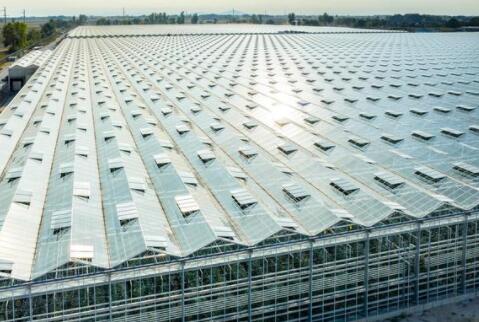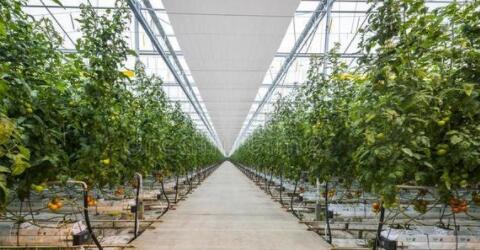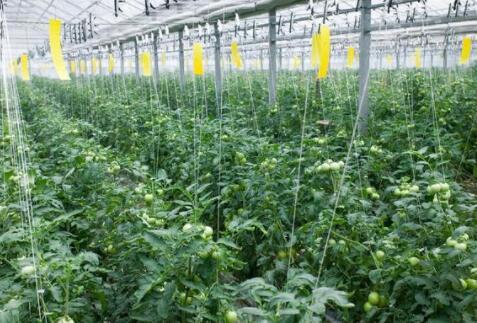
The real reason for the gap between the tomato production in the multi-span glass greenhouse and the
When it comes to Dutch glass greenhouses, we think of high-tech, large space, high yield, etc. The fact is that the same is true. The Dutch multi-span glass greenhouse substrate cultivation of vegetable crops ranks in the world's leading position, of which tomato production has reached 90 kg/m2. The average yield is more than 60 kg/m2; while the highest yield of tomato grown in rock wool (coconut bran) in the multi-span glass greenhouse is only 40-45 kg/m2, and the average level is only 25-30 kg/m2, which is far behind the Netherlands. Where is the real gap?

Climate environment
The Netherlands has a temperate maritime climate, with no extreme high and low temperatures throughout the year and plenty of rain. In summer, natural ventilation can achieve the ideal cooling effect and meet the temperature requirements of tomato growth. The plants can pollinate and set fruits normally, so there is no summer high temperature hazard. In most areas of northern my country, the winter is cold and summer is hot, and the use of fan water curtain cooling system in summer makes planting more difficult. Heating in winter increases the energy cost of tomatoes in my country.

Differences in greenhouse facility structure and planting strategies
The glass greenhouses in the Netherlands adopt high-space, soilless cultivation, precise water and fertilizer irrigation strategies, as well as the cover of super white glass on the top, and the sprayed aluminum alloy frame. They all have mature experience and quality systems. This is also one of the reasons for the gap. , But not the root cause.

Light supplement system and carbon dioxide management
Although the Netherlands' winter light resources are relatively weak, the Netherlands pays special attention to the research on the light environment control technology in the facility in view of the weakness of the country's light resources. Regarding the regulation of the light environment, one is to increase the light transmittance of the greenhouse, the other is to arrange crop stubbles reasonably, and the third is to install artificial lighting equipment to supplement the light.
The main cultivation method of multi-span glass greenhouses is soilless cultivation, and CO2 is often in a state of deficit. Studies have shown that the increase in CO2 concentration in other semi-enclosed greenhouses can increase the photosynthetic rate of crops, and tomato yield can increase by 20% or more. The greenhouse production in the Netherlands has CO2 supplementary equipment, adopting the cogeneration method, and the boiler works during the day. The CO2 generated is filtered and supplied to the production greenhouse to ensure that the CO2 concentration in the greenhouse is above 500 mol · mol-1, and the hot water is recycled and stored for use The greenhouse is heated at night.
Cultivation management
Tomatoes in the Netherlands are mostly grown in long-season varieties, while in my country they are mostly grown in short-season varieties. Tomato rock wool cultivation in Dutch multi-span glass greenhouses adopts long-season cultivation techniques. They are generally planted in mid-to-late December, harvested in March of the following year, and seedlings are drawn in early December. The average annual production cycle is 48 weeks, and 40-42 ears are harvested. my country has also introduced the Dutch long-season cultivation technology, but due to the influence of temperature and other climatic conditions, supporting cultivation and management facilities, equipment and technology, the tomato long-season rock wool cultivation stubble arrangement in the north is generally from late August to early mid-September. , The harvest will begin in mid-to-late November, and the seedlings will be pulled from late June to early July of the following year. 25 to 27 ears of fruit are harvested, and 35 ears of fruit are harvested at most. Under the conditions of this crop, the tomato harvest season in my country is nearly 3 months shorter than that in the Netherlands, and the number of harvested ears is as much as 15 ears. This is one of the fundamental reasons for the difference in yield.
Secondly, there are still many pitfalls in the prevention and control of diseases and insect pests, planting management, and planting of large seedlings. This is not something that can be accomplished overnight.
Tags:anti-reflective glass diffuse glass agricultural greenhouses glass greenhouse venlo greenhouse AR glass greenhouses glass agricultural glass horticultural glass #greenhouseglass #Antireflectiveglass #Diffusetemperedglass #Ultrawhitefloatglass #agriculturalgreenhouseglass #diffuseglass #horticulturalglass #Tomatogreenhouse #Coloredpeppergreenhouse #Lettucegreenhouse #Agriculturalgreenhouse #ARglass #venlogreenhouse #greenhouseglass #Antireflectiveglass #Diffusetemperedglass #Ultrawhitefloatglass #agriculturalgreenhouseglass #diffuseglass #horticulturalglass #Tomatogreenhouse #Coloredpeppergreenhouse #Lettucegreenhouse #Agriculturalgreenhouse #ARglass #venlogreenhouse #GlassManufacturer #invernadero #ArchitecturalGlass #ClearFloatGlass #FloatGlass
Previous:Considerations for flower glass greenhouses
Next:Common problems in the construction of intelligent multi-span greenhouses



















